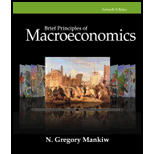
Sub part (a):
The nominal and real
Sub part (a):
Explanation of Solution
The GDP is the summation of the monetary value of all the goods and services produced within the political boundary of a country, within a financial year. There are two different ways of calculating the GDP of the economy and they are the real GDP and the nominal GDP. The real GDP is the GDP calculated at the constant prices. There will be a base price index and the value of goods and services will be calculated on the basis of the constant prices. Thus, it will measure the GDP of the economy on the same base year price index, which will help us to identify the inflation in the economy. The nominal GDP is the GDP calculated at the current prices. The GDP will be calculated by multiplying the quantity of goods and services produced with the current year’s market prices which will include the inflation impact.
The nominal GDP of the economy can be calculated by multiplying the quantity produced by the per unit price of the commodity. The quantity produced and price in 2016 was 100 quarts of milk and 50 quarts of honey. The prices were $1 and $2 respectively, for each quart. Thus, the nominal GDP of 2016 can be calculated as follows:
Thus, the nominal GDP of 2016 is $200.
Similarly, the quantity produced and price in 2017 was 200 quarts of milk and 100 quarts of honey. The prices were $1 and $2, respectively. Thus, the nominal GDP of 2017 can be calculated as follows:
Thus, the nominal GDP of 2017 is $400.
Similarly, the quantity produced in 2018 was 200 quarts of milk and 100 quarts of honey but the prices increased to $2 and $4, respectively. Thus, the nominal GDP of 2018 can be calculated as follows:
Thus, the nominal GDP of 2018 is $800.
The real GDP can be calculated by multiplying the quantity produced with the base year price level. Since the base year is 2016, the nominal GDP of 2016 will be equal to the real GDP of 2016, which is equal to $200.
In the case of 2017, the real GDP can be calculated by multiplying the 2017 quantity with the 2016 price as follows:
Thus, the real GDP of 2017 is $400.
In the case of 2018, the real GDP can be calculated by multiplying the 2018 quantity with the 2016 price. Since there is no change in the quantity produced in 2018 and 2017 in the two commodities of milk and honey, there will be no change in the real GDP of the two years and thus, the real GDP of 2018 will be the same as 2017, which is $400.
The GDP deflator is the implicit price deflator. It can be calculated by dividing the nominal GDP with the real GDP and multiplying the value with 100 as follows:
Thus, by substituting the values of nominal and real GDP in the equation, we can calculate the GDP deflator as follows:
Thus, the GDP deflator in 2016 is 100. Similarly, the GDP deflator for 2017 can be calculated as follows:
Thus, the GDP deflator in 2017 is also 100.
The GDP deflator for 2018 can be calculated as follows:
Thus, the GDP deflator in 2018 is 200.
These values can be tabulated as follows:
Table 1
| Year | Nominal GDP | Real GDP | GDP Deflator |
| 2016 | $200 | $200 | 100 |
| 2017 | $400 | $400 | 100 |
| 2018 | $800 | $400 | 200 |
Concept introduction:
Gross Domestic Product (GDP): It is the summation of the monetary value of all the goods and services produced within the political boundary of a country, within a financial year.
GDP deflator: It is an implicit price deflator.
Sub part (b):
The Percentage change in nominal and real GDP and GDP deflator.
Sub part (b):
Explanation of Solution
The percentage change in nominal GDP can be calculated by the following formula:
Thus, by substituting the values for the current year and previous year, we can calculate the percentage change in the nominal GDP as follows:
Thus, the percentage change in nominal GDP of 2017 is 100 percent.
Thus, the percentage change in nominal GDP of 2018 is also 100 percent.
Similarly, the percentage change in real GDP and GDP deflator can be calculated as follows:
The percentage change in real GDP of 2017 is 100 percent.
The percentage change in real GDP of 2018 is 0 percent.
The percentage change in the GDP deflator can be calculated as follows:
Thus, the percentage change in GDP deflator of 2017 is 0 percent.
Thus, the percentage change in GDP deflator of 2018 is 100 percent.
The prices in the economy remain the same in the year 2016 and 2017, which leads to no change in the percentage change in the GDP deflator. This is why the GDP deflator percentage change is zero. Similarly, the output levels remain the same in the years 2017 and 2018, which leads to the value of percentage change in the real GDP to remain at zero.
Concept introduction:
Gross Domestic Product (GDP): It is the summation of the monetary value of all the goods and services produced within the political boundary of a country, within a financial year.
GDP deflator: It is an implicit price deflator.
Sub part (c):
Economic well-being.
Sub part (c):
Explanation of Solution
The economic well-being increased much larger in the year of 2017, when compared to 2016 and 2018. This result is obtained from the analysis of the data that the real GDP remained the same in 2018 as the real GDP in the 2017. Thus, there were no changes in the real GDP after 2017. But after 2016, the real GDP increased from $200 to $400 in 2017. This means that the well-being rose more in 2017. Another reason why the well-being didn’t rise in 2018 was the price hike. The output remained the same, whereas prices doubled.
Concept introduction:
Gross Domestic Product (GDP): It is the summation of the monetary value of all the goods and services produced within the political boundary of a country, within a financial year.
Want to see more full solutions like this?
Chapter 5 Solutions
Brief Principles of Macroeconomics (MindTap Course List)
- 3. Consider a course allocation problem with strict and non-responsive preferences. Isthere a mechanism that is efficient and strategy-proof? If so, state the mechanismand show that it satisfies efficiency and strategyproofness. {hint serial dictatorship}4. Consider a course allocation problem with responsive preferences and at least 3students. Is there a mechanism that is efficient and strategy-proof that is not theSerial Dictatorship? If so, state the mechanism and show that it satisfies efficiencyand strategyproofness.5. Suggest a mechanism for allocating students to courses in a situation where preferences are non-responsive, and study its properties (efficiency and strategyproofness). Please be creativearrow_forward2. a) Consider a market where one firm (firm 1) currently produces, but a second firm (firm 2) is intending to enter and sell an identical product. The market has inverse demand given by p = 40 – Q, where Q is the total output sold in the market. Firm 1 has a marginal cost of 16 and firm 2 has a marginal cost of c < 16, with no fixed cost for either firm. Firm 2 has a choice of competing on price or quantity, with firms making their choices simultaneously (i.e. the market will be either a Bertrand or Cournot duopoly). If you were advising firm 2 on entering this market, how would you advise it to compete? To what extent would the size of firm 2’s cost advantage affect your advice? b) Now assume that firm 2 is aware that other firms are considering entering the market, so the market may over time change from a duopoly to an oligopoly with more than two firms. This would not change the nature of competition (i.e. any additional firms would set price or quantity in line with the first…arrow_forward1. Consider two firms (i=1,2) interacting in the market. Assume that firms compete in quantities and therefore they choose either to cooperate or not in each round. If a firm deviates it earns monopoly profit for a round and a punishment phase will follow from next round onwards (for ever) where both firms choose the Cournot quantity. Assume a discounting factor & and that firms meet in the market in every period. The demand facing the industry is p = 1 92. Let Q = q1 + 92 denote the aggregate industry output - 91 - level. Assume further that production is costless.arrow_forward
- Q4 (30 points) Subsidy in Auctions Consider a sealed-bid second-price auction with two bidders. Valuation of bidder 1 is drawn from the uniform distribution on [0, 100], and valuation of bidder 2 is independently drawn from the uniform distribution on [0, 300].arrow_forward$ A C ° Output Refer to the diagram, which pertains to a purely competitive firm. Which of the following statements is most accurate?arrow_forwardnot use ai please don'tarrow_forward
- not use ai pleasearrow_forwardFigure: Demand 3 If the two-firm oligopoly facing the market in this diagram is currently producing at the competitive output level and one of the firm reduces output by 4 units, the firms' profits would increase from 564596. O50524 50 to $48 O532 548arrow_forwardCan you show me how to do part d?arrow_forward
- Problem Set#8 Part I You are the manager of a firm producing a good in a particular market environment. The following table details the price charged (P) and the total cost (TC) incurred by your firm at various production levels (Q). Price (P) $125 Quantity (Q) Total Cost (TC) 0 150 125 1 175 125 2 210 125 3 255 125 4 310 125 5 375 125 6 450 125 7 535 125 8 630 125 9 735 125 10 850 125 11 975 125 12 1,110 125 13 1,255 125 14 1,410 125 15 1,575 1. Based on the information provided in the table above, identify the type of market structure in which the firm operates. Explain your reasoning! 2. Add seven columns to the table above, one for each of the following variables: AFC, ATC, VC, AVC, MC, TR, and MRarrow_forwardThe table below presents the demand schedule and marginal costs facing a monopolist producer. a. Fill in the total revenue and marginal revenue columns. Instructions: Enter your answers as a whole number. If you are entering any negative numbers be sure to include a negative sign (-) in front of those numbers. Leave no cells blank. Enter 0 if appropriate. Q 0 P ($) 8 TR ($) 0 MR ($) MC ($) 1 7 2 6 3 5 1 2 3 4 4 4 5 5 3 6 6 2 7 1 8 0 b. What is the profit-maximizing level of output? units c. What price will the monopolist charge to maximize profits? $ 7 8arrow_forwardnot use ai pleasearrow_forward
 Economics (MindTap Course List)EconomicsISBN:9781337617383Author:Roger A. ArnoldPublisher:Cengage Learning
Economics (MindTap Course List)EconomicsISBN:9781337617383Author:Roger A. ArnoldPublisher:Cengage Learning
 Macroeconomics: Principles and Policy (MindTap Co...EconomicsISBN:9781305280601Author:William J. Baumol, Alan S. BlinderPublisher:Cengage Learning
Macroeconomics: Principles and Policy (MindTap Co...EconomicsISBN:9781305280601Author:William J. Baumol, Alan S. BlinderPublisher:Cengage Learning Principles of Economics, 7th Edition (MindTap Cou...EconomicsISBN:9781285165875Author:N. Gregory MankiwPublisher:Cengage Learning
Principles of Economics, 7th Edition (MindTap Cou...EconomicsISBN:9781285165875Author:N. Gregory MankiwPublisher:Cengage Learning Essentials of Economics (MindTap Course List)EconomicsISBN:9781337091992Author:N. Gregory MankiwPublisher:Cengage Learning
Essentials of Economics (MindTap Course List)EconomicsISBN:9781337091992Author:N. Gregory MankiwPublisher:Cengage Learning Principles of Economics (MindTap Course List)EconomicsISBN:9781305585126Author:N. Gregory MankiwPublisher:Cengage Learning
Principles of Economics (MindTap Course List)EconomicsISBN:9781305585126Author:N. Gregory MankiwPublisher:Cengage Learning





